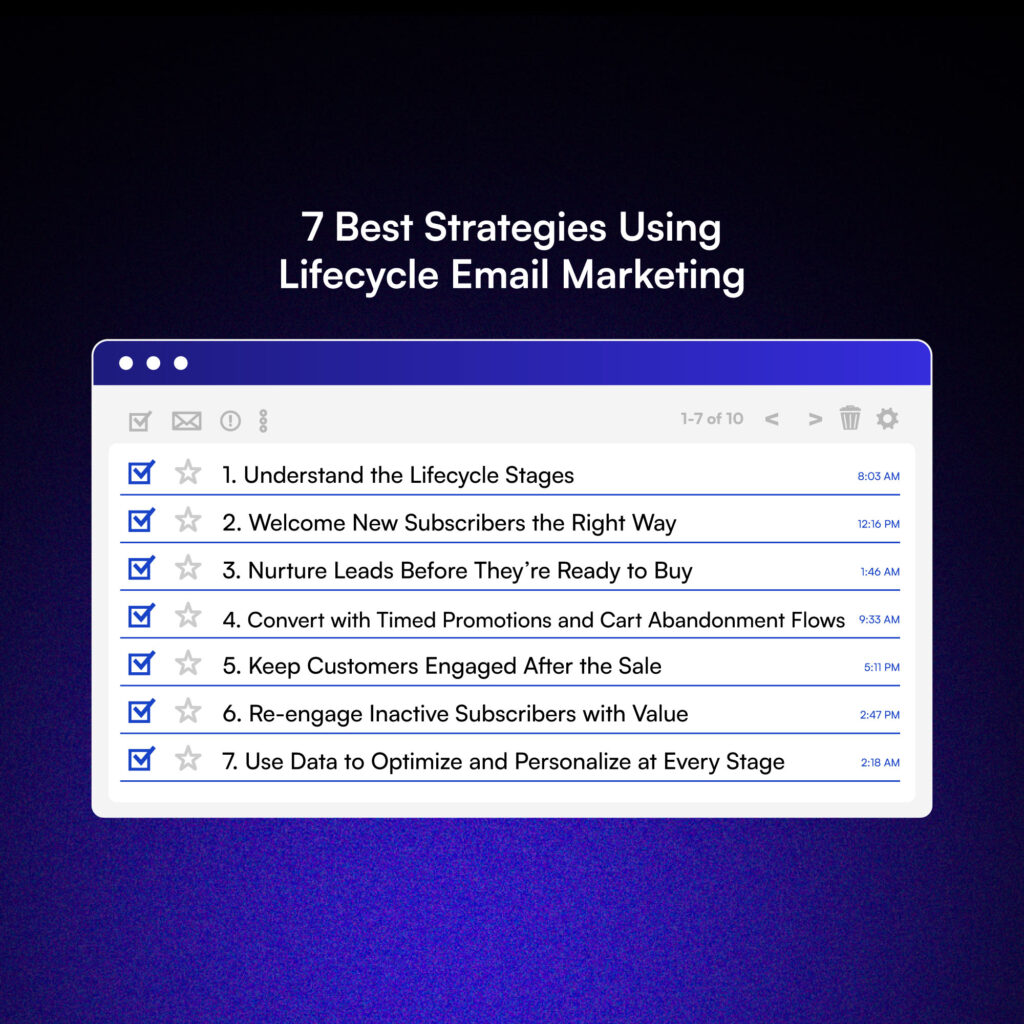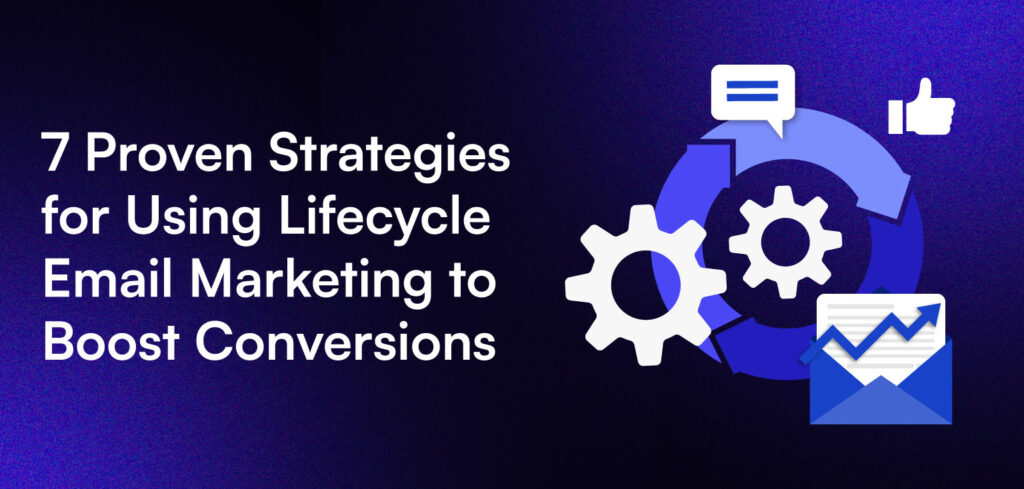Whether they just signed up, purchased, or haven’t engaged in a while, your emails meet them right where they are. It’s smart, scalable, and wildly effective.
Here’s the thing: most brands only scratch the surface.
A welcome email, maybe a promo or two, but that’s it. Meanwhile, your customers are moving through stages, and you’re missing key moments to connect, convert, and keep them coming back.
In this guide, we’ll break down the most effective lifecycle email marketing strategies, what makes them work, and how you can apply them today to drive more engagement and email marketing conversion rates without overwhelming your audience.
7 Best Strategies Using Lifecycle Email Marketing

1. Understand the Lifecycle Stages
Before you can market to anyone, you need to identify your potential customers. This is the very top of the funnel, where visitors are discovering your brand for the first time. Your goal at this stage is simple: capture their interest and earn permission to start a conversation via email.
Instead of letting casual browsers leave without a trace, use this moment to offer something valuable in exchange for their email address.
Strategies to capture prospects:
- Offer a lead magnet: Give people a reason to subscribe. Think downloadable guides, checklists, exclusive content, or a first-time discount.
- Use exit-intent popups: These popups detect when a user is about to leave your site and offer a compelling reason to stay or subscribe.
- Create high-value content: Blogs, quizzes, videos, and tools that solve a problem or entertain can drive traffic and grow your list organically.
By focusing on attracting and converting prospects early on, you’ll set yourself up for success in every other stage of the lifecycle.
Pro tip: Pair lead magnets with segmentation. For example, if someone downloads a “Beginner’s Guide,” tag them as new to your space so you can tailor future emails to their experience level.
2. Welcome New Subscribers the Right Way
Your welcome email is your digital handshake, so make it count. This is your first impression, and it’s not just about saying hi.
It’s your chance to:
- Set expectations – Let people know what kind of emails they’ll receive and how often.
- Show your value – Share what makes your brand different or offer a free resource to get them hooked.
- Invite engagement – Ask them to follow you, take a quiz, or explore your bestsellers. Keep it simple, clean, and focused on them, not you.
Example: “Thanks for signing up! You’ll get tips, exclusive offers, and early access to our best stuff, starting with this free guide.”
Pro tip: Use a short welcome series (2–3 emails) instead of just one. It gives you more space to build trust and introduce your brand gradually.
3. Nurture Leads Before They’re Ready to Buy
Most people don’t buy immediately, and if your emails are all “Buy now,” you’re missing the mark. Lifecycle email marketing allows you to educate, build trust, and stay on your mind until they’re ready.
This stage is all about value:
- Educational content helps them understand their problem and how to solve it.
- Product benefits show how your solution fits into their life.
- Social proof, like customer testimonials or reviews, adds credibility without pressure.
Instead of rushing the sale, you’re laying the groundwork. These emails say, “Here’s why this matters,” not “Here’s 20% off again.”
Pro tip: Use email engagement to guide the next steps. If someone clicks your how-to guide, follow up with a success story that connects the dots.
4. Convert with Timed Promotions and Cart Abandonment Flows
Once your lead is warmed up, the right nudge can make all the difference. This is where behavioral triggers shine especially when someone browses a product, adds to cart, then disappears.
Use lifecycle email marketing to:
- Trigger well-timed promotions based on browsing or engagement behavior. These feel personal and relevant, not random.
- Recover abandoned carts with reminder emails that gently prompt users to complete their purchase.
Effective cart flows include the product they left behind, a short reminder message, and a CTA that feels helpful instead of pushy.
Pro tip: Add urgency to your reminders with phrases like “Almost gone!” or include trust elements like free returns or support info.
5. Keep Customers Engaged After the Sale
The customer journey doesn’t end at checkout; in fact, it evolves. Post-purchase emails are key for retention and long-term value.
Here’s what to include:
- Thank-you emails that make the customer feel appreciated, not just converted.
- Onboarding content that explains how to use or care for their product.
- Cross-sell suggestions that actually make sense based on their purchase.
This stage builds loyalty, reduces returns, and opens the door to future sales.
Pro tip: Space your post-purchase flow out instead of dumping everything in one email. A drip sequence builds engagement naturally.
6. Re-engage Inactive Subscribers with Value
Just because someone stopped opening your emails doesn’t mean they’re a lost cause. A smart win-back campaign can rekindle interest if it’s done with tact. The key? Don’t beg. Bring value.
Instead of “We miss you,” try:
- A juicy offer they haven’t seen before
- A product update or launch they might have missed
- A roundup of content they’ll actually find useful
This approach says, “Here’s something we made for you,” not “Please come back.”
Pro tip: Set a re-engagement trigger after 60–90 days of inactivity, then automatically remove contacts who still don’t engage to protect your deliverability.
7. Use Data to Optimize and Personalize at Every Stage
Your lifecycle email marketing should evolve as your audience does. Every open, click, and purchase gives you clues on how to serve them better.
Start simple:
- Track open and click-through rates to see what’s landing
- Use A/B tests on subject lines, timing, and CTAs
- Segment based on behavior (not just demographics)
From there, you can:
- Send more frequent updates to high-engagement users
- Pull back on frequency for those losing interest
- Adjust your product recommendations based on what they’ve browsed or bought
Pro tip: Review performance every quarter. The most effective lifecycle email marketing flows are never “set it and forget it”; they’re built to learn and adapt.
Your Next Move
Lifecycle email marketing isn’t about blasting your list more often. It’s about showing up at the right moment, with the right message, for the right person.
When each stage of the customer journey has its strategy – welcome, nurture, convert, retain, and re-engage – you eliminate guesswork and start achieving real results.
The best part?
Most of it can be automated once it’s dialed in. So, instead of chasing opens and unsubscribes, you’ll start building lasting connections that lead to repeat business and higher lifetime value.


